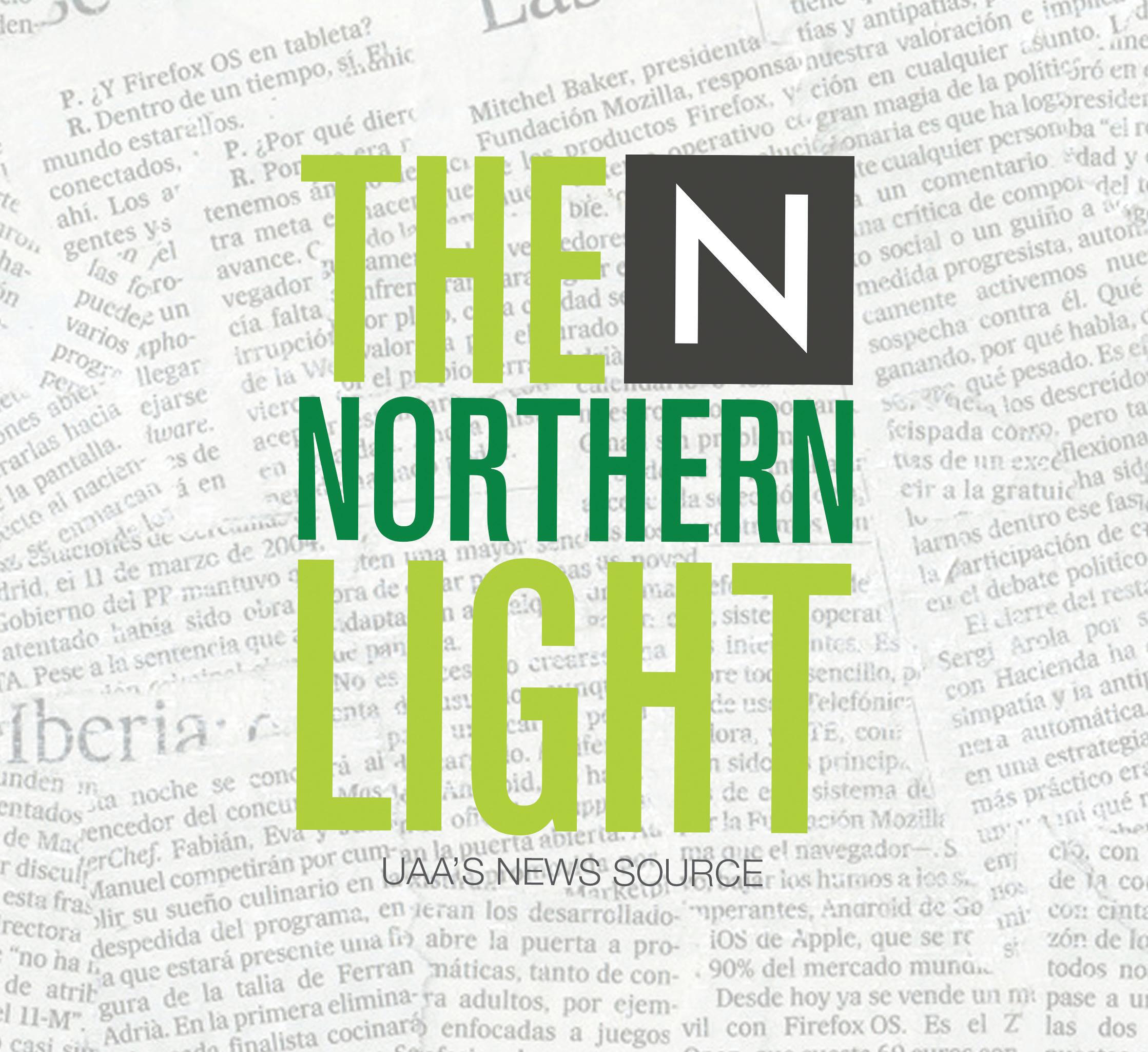NEWS PAGE 2
‘Helper flags’ show community support for preventing suicide at UAA

Seawolf 5th Line supports UAA hockey on and off the ice


NEWS PAGE 2
‘Helper flags’ show community support for preventing suicide at UAA

Seawolf 5th Line supports UAA hockey on and off the ice

By Taylor Heckart news3@thenorthernlight.org
The Northern Light interviewed students around campus about their opinions on AI as part of an investigative series into artificial intelligence..
Opinions varied from student to student, with many pursuing different degree programs.
Ahmed Alabdulbaqi is a finance major. AI is a current topic in his computer information science class, and he’s writing a paper on it.
Alabdulbaqi said that embedded AI, like spell check or Grammarly, has a place in education. Alabdulbaqi said that it’s a good tool, like a “personal helper,” but warned against an over dependence on it. He said that AI can’t substitute teaching or people.
Aidan Jackson, an English major, said that she “hates Grammarly.” Jackson said that Grammarly implements a strict system of what English should be – removing more colloquial English, and therefore making writers sound clinical and “western.”
Jackson said that tools like Grammarly feel inauthentic and remove diversity from writing. Not to mention, she said, these tools aren’t always right.
Jacob Weerasinghe, who’s

studying Business Management, said that he believed that AI definitely has a place in education. He said that AI tools like spellcheck are useful, but AI shouldn’t be used in technical research or narrative essays.
He said that AI arguments boil down to two main ideas; one being that AI use is taking the easy way out, and the other being that it simply makes life more efficient.
For Weerasinghe, AI use is
similar to the way we deal with remembering phone numbers –he’s memorized a few key phone numbers, but for the most part, it’s more efficient for his phone to remember the rest.
Madelyn Kirby, who’s studying education, said that she’s worried that AI will take away children’s ability to talk to a real person, and they won’t be able to learn the social lessons they normally do from talking to people.
Kirby said that she under-
stands that college is difficult, but she doesn’t like when students use AI chatbots like ChatGPT for essays. She said that using AI in that way takes away from valuable learning experiences.
One student using AI in education is Aden Burch, a nondegree seeking ANSEP student. He said that he’s used AI to help him understand complicated topics in classes like chemistry.
He said that in larger classes,
where one-on-one time with the professor is limited, AI can be a useful tool to explain complicated topics that a student needs more help understanding.
Burch said that he doesn’t believe that AI will become an issue when it comes to academic writing. He said that AI can’t bring in its own ideas, and can’t actually be creative; it’s just a jumble of other people’s work.
J.P., an aviation major, said that he sees AI as a tool. He said that some people use it as a tool and a resource, while others will abuse that power. He said that AI is “almost cheating” when you rely on it at all times, but it works as a backup or a “quick refresher” tool when used properly.
Donnie Lawhead, who studies finance, said that he finds himself in the middle of the debate. He recognizes the benefits and drawbacks, and said that there have been instances where professors have encouraged him to use it in specific contexts. Lawhead said that it comes down to how people use AI, and how honest they actually are about it.
Lawhead said that he doesn’t yet know where AI will go, but he doesn’t really care for it, and doesn’t want to use it for now.
The vacant position leaves the House of Representatives in uncharted territory with only weeks before a potential government shutdown.
By Kyle Ivacic news2@thenorthernlight.org
Representative Kevin McCarthy was ousted from his position as Speaker of the House on Oct. 3 in a vote of 216 to 210. The action is unprecedented, and leaves the House of Representatives without a speaker until a new one is voted in.
An interim Speaker – Patrick McHenry – was selected following the vote to remove McCarthy from his position. McHenry was one of McCarthy’s selections to succeed his position for the interim in the event of an ousting. McHenry’s power as interim speaker is limited and ABC news reports that he will focus on making sure the House elects a new speaker, as rules currently state that the House cannot act on new legislation until a new speaker is elected. Whether those rules can be adjusted to allow representatives to take action on time-contingent matters – such as government funding –
will be seen in the coming days and weeks.
The vote for a new speaker might take place as soon as Oct. 11, according to NPR. It will likely be contentious due to conditions in the House of Representatives and political tensions in the nation at large.
McCarthy’s short-lived speakership came after long deliberation and 15 rounds of voting by the House in January. He won the position only by making concessions to a small group of House Republicans – most of whom are part of the House Freedom Caucus. McCarthy needed their votes because Republicans have a slim majority in the House of Representatives. One concession made was a change to House rules to allow for a single representative to force a vote on the removal of the speaker.
Representative Matt Gaetz used the new rule to force the vote after he and other House Republicans voiced opposition to the temporary government
funding bill – negotiated in part by McCarthy – passed by the House on Sept. 3, narrowly preventing a government shutdown.
Many media agencies reported that McCarthy came under fire In May and June of this year by the same group of Republicans responsible for his ousting when he struck a bipartisan deal to suspend the debt ceiling until 2025. According to an article from NPR, Representative Scott Perry – a member of the Freedom Caucus – said that the debt deal “fails completely.”
The ousting leaves many officials fearing a government shutdown come Nov. 17, when the temporary funding bill is set to expire. Echoing this fear, Senator Thom Tillis of North Carolina told The Hill, “There are clearly a few choices that they could make that make it almost certain we go into a shutdown posture.” Whether or not the House is back in order by the November deadline remains up in the air.


UAA’s education program has experienced many obstacles in the last halfdecade – with the impact of CAEP’s accreditation revocation being the largest.
By Hannah Dillon opinion2@thenorthernlight.org
UAA’s School of Education has seen many obstacles in recent years, but it still exists. Due to the demand for new teachers in the state of Alaska, UAA has seen a large uptick of education degree seekers.
In 2018, UAA’s school of education lost its initial licensure accreditation from the Council for the Accreditation of Educator Preparation. Initial licensure accreditation is a certification necessary for becoming a P-12 educator.
This meant that UAA lost accreditation for some of its base education programs such as the Elementary Bachelor of Arts.
The aftermath of the accreditation revocation made it difficult or impossible for new students to seek cartain education degrees at UAA.
Programs like Early Childhood Special Education and Master of Education in Teaching and Learning were not affected – those are programs affiliated with advanced licensure.
UAA still has their advanced licensure accreditation, which allows students who have already received initial licensure to continue some programs.
Accreditation is important because CAEP accredits educator preparation programs, where future teachers are taught how to be educators. Accreditation through CAEP makes sure all standards to become an educator are met.
Before 2018, Dean of Education Tonia Dousay said the education department had approximately 40 faculty – while current numbers sit at a mere eight. These faculty oversee early childhood education, special education, educational literacy, educational leadership and teaching and learning.
Dousay noted that there are approximately 22 education programs currently running.
With only four universities in the state that can certify teachers, Dousay said that admission demand is high.
With 22 simultaneous programs and only eight faculty, UAA did not have enough faculty to teach all of the School of Education’s classes last year.
“We went from zero students, to 40, to 60. I looked last night, there’s 102 in the undergrad program as of yesterday. We have almost tripled enrollment in that program. We are conducting faculty searches this year,” said
Dousay.
A new summer class called “Praxis Prep” is now offered as an elective to help students prepare for the Praxis exam. The exam evaluates a student’s knowledge of their previously taken courses and future educator performance, according to the Praxis webpage.
Along with standard classes for future educators, a new program has been developed after UAA’s initial licensure accreditation removal in 2018.
The new program creates students who are labeled as “Stop Out Students.” Six students are currently participating in the program and it is designed to help them integrate back into classes after they stalled out in 2018. UAA will be giving out awards through the program, which will cover at least one credit or one class.
Dousay said that, while the number of students who graduated after transferring to alternative programs during or after the school of education lost initial licensure accreditation is unknown, many students stalled out, with most at the early childhood level.
Alissa Rountree is a local elementary Anchorage

School District educator who attended classes at UAA during the time accreditation was lost.
Rountree decided to finish her degree at University of Alaska Southeast, with many of her UAA graduating class also making the decision to transfer to other University of Alaska campuses.
“I wasn’t really worried I wasn’t going to be able to graduate. I just didn’t know what that would look like. I didn’t know if I would have to transfer schools or take longer. I guess I was worried I wouldn’t graduate on my
same projected time. But I knew they would have to figure something out to help out the students who were in my situation,” said Rountree.
Rountree continued, saying that “When I went to get my masters, I noticed one of my pre-reqs was you have to have graduated from an accredited program. I wouldn’t have been able to do my masters degree through this program if I had not transferred. That was one of the reasons I decided not to stay at UAA, just to ensure I had the option of teaching in a different state.”
Dousay said “As soon as we get our CAEP initial licensure back, we can offer any undergraduate insecure plan. It’s likely that we will target the performing arts because UAA, of the three universities, has the larger performing arts programs. We might look at some of the career and technical education fields.”
UAA still has accreditation on advanced programs, but initial licensure will not be renewed until 2028.
UAA’s Peer Health Education team is destigmatizing conversations around suicide while showing UAA students they’re not alone.
By Taylor Heckart news3@thenorthernlight.org
Brightly colored flags have been flying in the skybridge between the Avis Alaska Sports Complex and Rasmuson Hall this September. The flags where hung by UAA’s Peer Health Educator team, and represent the community of support that exists around suicide prevention at UAA.
Peer health educators are UAA students who provide peer-to-peer education and programming on health-related topics. Their programming encompasses a wide variety of topics in addition to suicide prevention.
Hannah Boron is a peer health educator, and says that the premise behind the flags is simple. Peer
health educators ask students on campus to write the name of someone who helped them “during their darkest hours or the times that they struggled” on a flag. All of the flags are then hung up together in a space where the UAA community can see them.
“So then when we hang them all up, right, it’s kind of an individual thing where you look at the flag
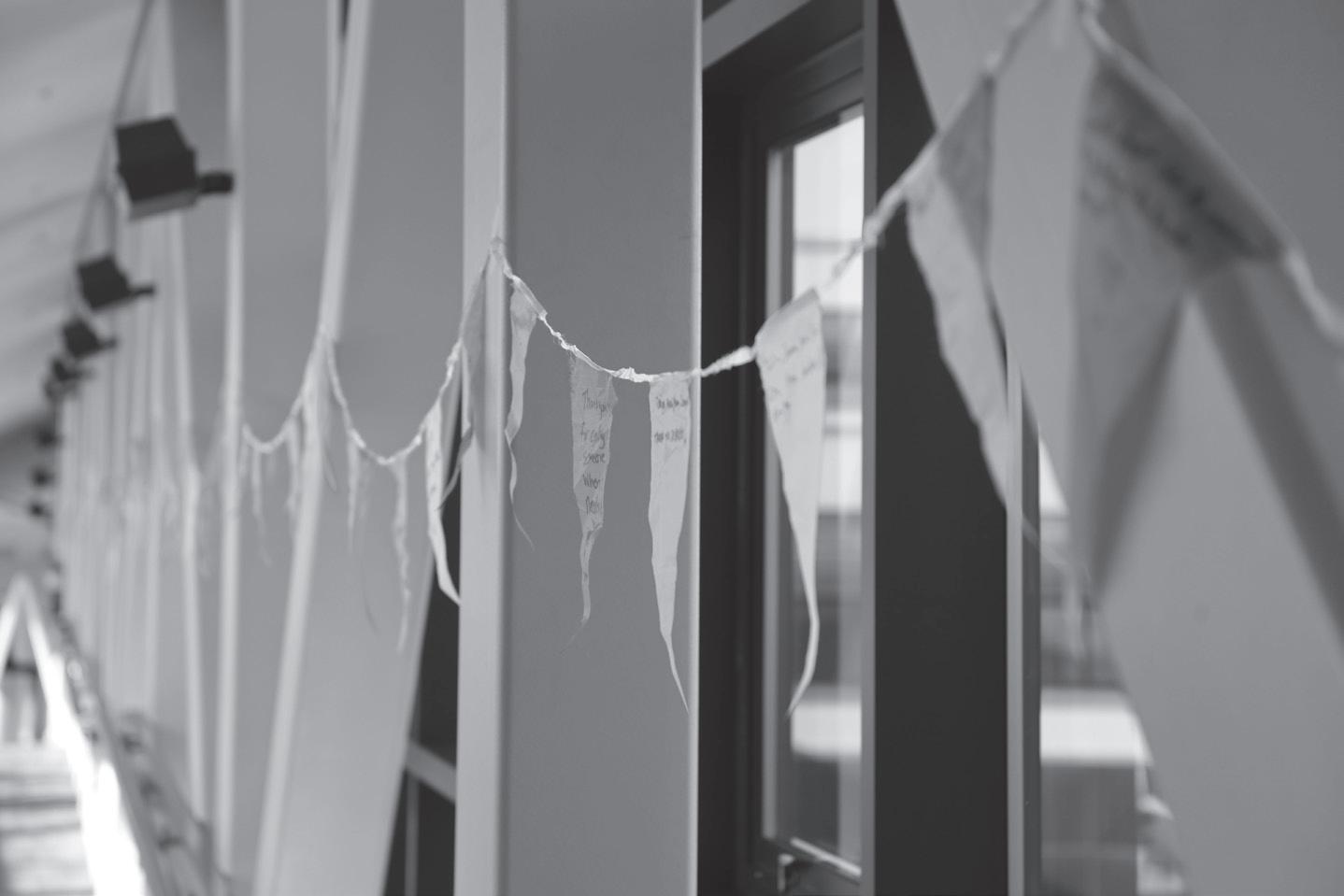
and say ‘that was my system of support,’ but then you see how everybody else is supported in their lives, and you can connect to that as well,” said Boron.
The rate of suicide in Alaska is significantly higher than the national average, and according to the CDC Alaska has the third highest suicide rate in the nation.
Boron said that there is a big misconception around talking about suicide. “Talking about suicide or asking somebody if they’re suicidal is not going to make them want to commit [suicide] more, and a lot of people are afraid to step forward because they’re afraid of stressing somebody out or making it worse.”
She said that talking to someone is the first step toward getting them the support that they need.
Haley Lugers, an assistant with Peer Health Educators, said that suicide is an issue that impacts communities across the state.
“Suicide affects almost
everybody in our state, especially in rural populations. When someone dies, it really affects the entire community,” said Lugers, “So I think that’s why it’s really important that we talk about suicide. Even though it’s [become] less stigmatized over the last few years, it’s still really taboo to talk about, even though it affects almost everybody that we know, in some way.”
Lugers said that the helper flags are one way to continue to destigmatize the conversation around suicide while showing the UAA community that support is out there.
In October, Peer Health Educators will be doing a similar project for Domestic Violence Awareness Month in October. White shirts with words of support for domestic violence survivors will be hung up in the library.
For students in need of support, there are many suicide prevention and mental health resources both on and off campus.
The Student Health
and Counseling Center –located on the first floor of Rasmuson Hall – has mental health support for those who may be struggling with suicide.
UAA also has a Psychological Services Center, where students seeking counseling can book appointments with UAA masters and doctoral students who are supervised by professional psychologists. Fees are based on students’ income level.
Students who are concerned about another student can submit anonymous reports to UAA’s Care Team. Professionals from the Care Team can intervene and help UAA students find support.
State and national hotlines for those seeking immediate assistance include:
The National Suicide Lifeline: 988
The Alaska Careline: 1-877-266-4357
The Trevor Project, for LGBTQ individuals: 1-866-488-7386
Anchorage’s Department of Maintenance and Operations is gearing up for this winter season with more training and better coordination.
By Matthew Schmitz editor@thenorthernlight.org
Last December, the city experienced several days of extreme snowfall, which caused major disruptions to residents. According to an article in The Anchorage Daily News, “backto-back systems dumped at least 3 feet on much of Southcentral Alaska.”
The snow hit during the last weeks of UAA’s fall semester, causing campus closures and disrupting classes during finals week. While snow was cleared from campus in a timely manner, other roads around Anchorage were a bigger issue for students.
Chi Xiong is a student at UAA. He said that winters have been mild recently and that he’s missed seeing heavy snowfalls, so it was fun to see all the snow.
But the weather and street conditions affected him negatively as well.
He said that he and his family would normally visit his grandma weekly in Anchorage, but those visits were put off for several weeks because of the poor road conditions.
At the Sept. 26 Anchorage Assembly meeting, member Zac Johnson gave an update on the city’s preparations for snow plowing this season. He said he received an update from the manager for street maintenance and municipal manager at an enterprise and utility oversight committee meeting, which Johnson vice-chairs.
Johnson said, “Everyone acknowledges that there was room for improvement after snow plowing last year. And it’s encouraging to see the effort that the Muni is putting in to coming up with a better plan for this year.”
He said that there are additional contracts being prepared to help supplement the city’s own snow removal operation and the city does not foresee needing additional dumpsites sites this year.
He said that Street Maintenance has hired eight employees, but there are still 16 vacancies.
A lack of employees was an issue that Street Maintenance was struggling with last year, according to an article in the Anchorage Daily News. A few weeks before the snow fall, former City Manager Amy Demboski told the assembly at a meeting that Street Maintenance was down 33 operators.
Johnson said that there is also an effort to improve communication between the city and state when it comes to road clearing.
“Some people may not realize that Anchorage is sort of a mishmash of state owned and maintained roads and municipally owned roads. And some -
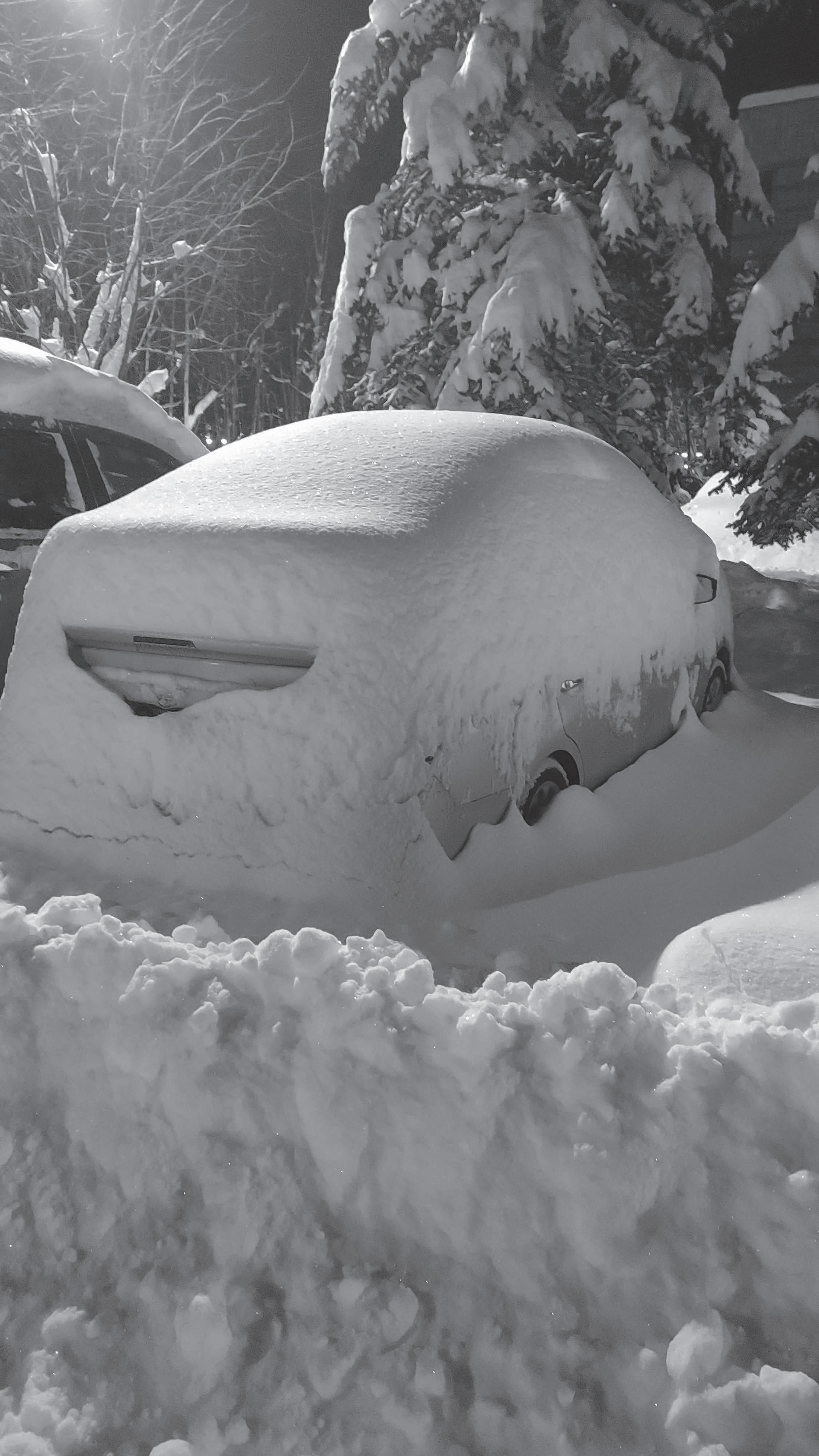
times those efforts have not always seemed to be operating in harmony when it comes to snow clearing, so there’s an effort to do better in that regard.”
Johnson spoke with The Northern Light in an interview and added some information to his assembly meeting update.
He said the contracts he described at the meeting were nonencumbering, meaning that the city would only pay for the service if needed. He said having the contracts ready beforehand
would help avoid delays.
And, he said, last year there was a problem with keeping the city’s road graders operational because of long lead times for replacement parts. They are now stockpiling some of the common parts to avoid that problem again.
Johnson also talked about the worker shortage problem: “We also had challenges attracting and retaining enough operators [last year] to actually use the equipment … I know the human
resources department has made some adjustments to make the positions more attractive.”
He said there are eight seasonal workers expected to join street maintenance when construction season ends, in addition to the eight new-hires. He also said that there is improved preseason training for the snow plow operators.
He said one way residents can help with the plow effort is to avoid pushing snow from their driveways into the streets,
which is a violation of city code.
If people have concerns, Johnson said they should reach out to assembly representatives.
“We recognize that we had some lessons to learn from last year. I think we’re taking those lessons to heart and we have a better plan for this year. It’s not to say it will be perfect. And if people have concerns … reach out and let us know and we’ll do our best to address it ... But just please be respectful of the people out there doing the hard work at the strange hours to keep the city functional.”
Kara Monroe, supervisor of UAA’s grounds and landscaping department, talked about the university’s efforts to keep the campus cleared of snow last year.
As Johnson pointed out at the assembly meeting, a major challenge to street plowing in Anchorage is the complex street ownership between the city and state. And many streets in Anchorage — including some at UAA — rely on private services to clear them.
Monroe said that all three streets at the intersection north of Rasmuson Hall have different entities responsible for their maintenance.
The city is responsible for Mallard Lane, UAA for Seawolf Drive and the Anchorage School District for Career Center Drive, she said.
Monroe said that UAA uses a contractor to clear the snow from the campus streets and parking lots and that their contractor prioritizes campus during a snowfall.
She said that the grounds department takes care of the sidewalks around campus and Residence Life has a team for the paths around the dorms. Their priority, she said, is to initially get paths cut after a snowfall — coming back to gradually widen them after all the paths have been cut.
She said it was a lot of work last year, but they were able to get everything cleared.
She said that one part of campus with known issues is the residence hall parking lots.
In order to clear out the parking lots, they have to give a notice to students to move their vehicles. And, she said, this can be challenging — especially over winter break because many students leave their vehicles on campus.
They tow vehicles that aren’t moved during a plow out, so they don’t do any residence parking lot clearing until after the break.
Regarding the December snowfall and their plowing operations, she said, “There wasn’t anything that … didn’t work out; that was the test, and I’m hoping – statistically – we don’t have a winter like that again.”
The famous poet talked with audiences about the intersection between poetry and science, and what it means to create art in
By Taylor Heckart news3@thenorthernlight.org
Poet Jane Hirshfield participated in three events celebrating the 50th anniversary of the Consortium Library on Sept. 28. Two of the events were hosted at UAA: a creative writing talk at noon and a panel conversation at 4 p.m.
The event was co-hosted by the Consortium Library and Alaska Quarterly Review.
According to the Poetry Foundation, Hirshfield’s works have been finalists for multiple awards. Hirshfield received the 70th Academy Fellowship for distinguished poetic achievement by The Academy of American Poets, and is a member of the American Academy of Arts and Sciences.
Seats were filled for both her creative writing talk and the panel discussion. At the talk, which took place at noon, Hirshfield explained her writing process. She said that, “a poem always begins with some precipitant,” some idea that would then later become the basis of a
poem.
Hirshfield said that a lot of her ideas come from observations in the world around her. Recently, much of those observations are on the changing environment around her and its connection to climate change.
“I have lived long enough to see the world I’ve grown up in change,” said Hirshfield. She talked about how she used to be able to go camping without water filters, but now filters have become a necessity with increasingly polluted waters.
Once a few words have come to her, she begins her writing her poems.
Hirshfield told aspiring authors to write “noble failures,” because, she said, writers who aren’t creating failures aren’t taking enough risks. She reminded the audience that everyone writes badly sometimes.
The panel discussion at 4 p.m. featured Hirshfield, former Alaska Writer Laureate Nancy Lord, climate action advisor for The Nature Conservancy Stephanie Holthaus and Iñupiaq poet Marie Tozier.
Like Hirshfield’s creative writing talk, a large part of the panel discussion focused on the intersection of science and poetry in the context of climate change.
Lord said that poetry and science are parallel ways of looking at the world, not opposites.
She said that when it comes to creating art around the environment and climate change, a way to combat hopelessness is to write about something that encompasses joy, and to center on solutions-based issues.
Holthaus said that she is not a poet, but that poetry was a part of combating climate change.
“We need poetry to understand why we’re doing what we’re doing.”
Tozier said that it’s important to center indigenous ways of knowing in these conversations, and that there are lessons to be learned from indigenous communities – especially when facing climate change. She said that it can sometimes be hard to share her poetry, because it is often from a different point of view from other poets, but that
the
midst of a climate crisis.

it increases her drive to share them.
Hirshfield talked about her project “Poets for Science,” which was born out of the 2017 March for Science, when Hirshfield curated a series of scientific poems that she brought with her on the march.
Poets for Science has grown into an entire collection of posters, banners and exhibits of curated scientific poetry that has traveled across the United
States.
According to the Poets for Science website, “Each poem in the Poets for Science collection was specifically chosen by Jane Hirshfield to demonstrate the connection between poetry and science, and how each discipline can inform the work of the other.”
Hirshfield’s final event in Anchorage was a poetry reading and book signing at the Anchorage Museum.
The Arc Gallery features a UAA art professor’s watercolor paintings –representing dreams, rattlesnakes and “totally alien” composition.
By Hannah Dillon opinion2@thenorthernlight.org
Garry Mealor is a professor of art who has taught drawing and watercolor classes for nearly 30 years at UAA. The Arc Gallery – next to the Consortium Library – is hosting Mealor’s 200th exhibition, “Big Old Watercolors,” featuring three distinct approaches to watercolor.
The Arc Gallery features Mealor’s paintings “Shades of Blinds,” “Mind Meander,” “Cat’s Cradle” and the three perspectives of “Orange in the Copper.” These paintings fill the room with their larger than life imagery.
Before Mealor begins to paint on his final canvas, he first creates a study. A study is when the artist essentially paints a rough draft of the final painting. Mealor painted his studies on an area about a quarter the size of the final project.
Mealor also used his study for his watercolor students to see changes that occur in the process of creating an art piece.
Mealor uses transparent watercolor – meaning he does not
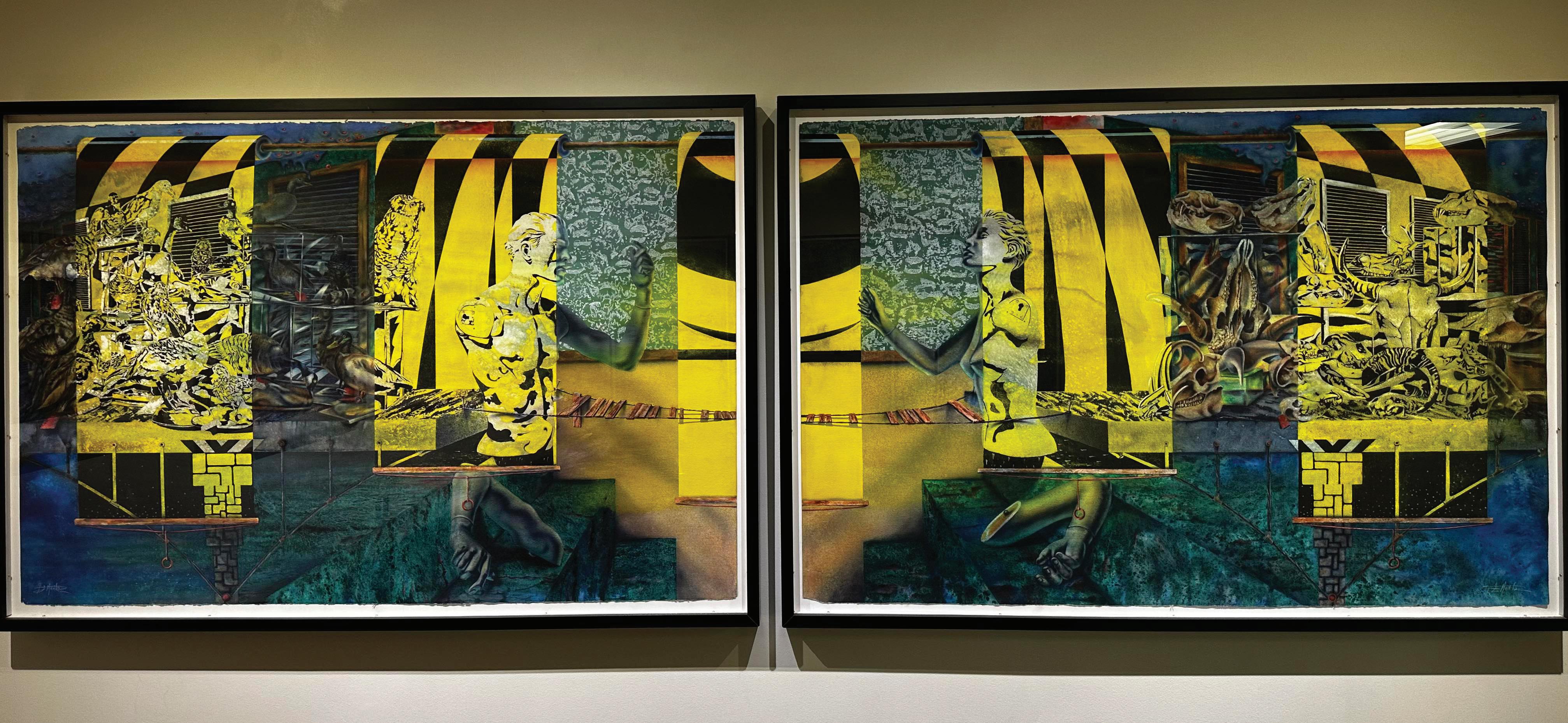
use any white paint or premixed black paint. The use of transparent watercolor renders the artist unable to cover any mistakes that may be made.
Mealor said he would watercolor a highly realistic piece and then wash it out. He threw in primary and secondary colors with water while watching as everything blended together. Mealor then waited for it to dry before going back to the painting and touching it up.
“I lay them flat on my studio
floor, and I just go crazy. Get spray bottles, cups, paint, everything and dump it and just totally saturate it. Things just start to blend around - it’s actually kind of fun,” said Mealor.
Mealor uses wooden dowels underneath the paper to direct the water. He places primary colors to blend on the paper to create secondary colors, but the artist must be careful not to let the secondary colors mix into mud.
In his painting “Shades of
Blinds,” Mealor said he had a lot of fun painting in a way he had never done before. He found his inspiration in a lecture he attended some time ago.
Mealor said the lecture encouraged artists to try something they never had before. Changing composition and “approach a painting in a way that is totally alien,” said Mealor.
Mealor said he broke every rule he normally has when completing a painting. “The perspective in this is all wrong
... I usually spend a lot of time on composition, this one, I just measured everything off by five inches.”
“Shades of Blinds” is also the only watercolor Mealor has done with colored pencil and the only painting he has done professionally with an opaque watercolor called gouache.
The difficulty in this piece originates at the first thought of a painting like “Shades of Blinds”.
“You have to know where all your highlights are at the very beginning because you can’t cover up anything. If you do make a mistake, it has to become part of the painting,” said Mealor.
Watercolor is Mealor’s only medium. “You’re never going to master it, in my opinion, that’s why I love it. Because it’s something that, even now after all these years, it still gets frustrating.”
“Sometimes you come up with a painting that is better than what you intended… I like the idea that nothing is going to come easy. There’s always going to be a lot of risk, things aren’t always going to go your way and you better be able to deal with it. Roll with the brushes,” said Mealor.

Seawolf 5th Line supports UAA hockey on and off the ice
Seawolf 5th Line raised more than $3 million to reinstate the UAA hockey team. Today, the non-profit corporation continues to support the Seawolves.
By Avery Williamson sports2@thenorthernlight.org
UAA hockey was brought to an abrupt end in 2020 when it was cut because of reductions in state funding.
GoSeawolves.com made the announcement in Aug. 2020 that “in light of declining budgets, UAA Chancellor Cathy Sandeen and Director of Athletics Greg Myford made the difficult decision to eliminate four programs from the UAA roster.”
Men’s hockey – along with women’s gymnastics and men’s and women’s skiing – was eliminated at the beginning of the 2021-22 athletic season. However, Anchorage wasn’t ready for their college hockey team to disappear.
Seawolf 5th Line began when “a group of hockey fans and community members came together to help save Seawolf Hockey,” founder and chairman of Seawolf 5th Line Kathie Bethard wrote in an email to The Northern Light.
Through fundraising and support from the community, Seawolf 5th Line successfully raised $3 million to reinstate the UAA hockey program on Aug. 31, 2021.
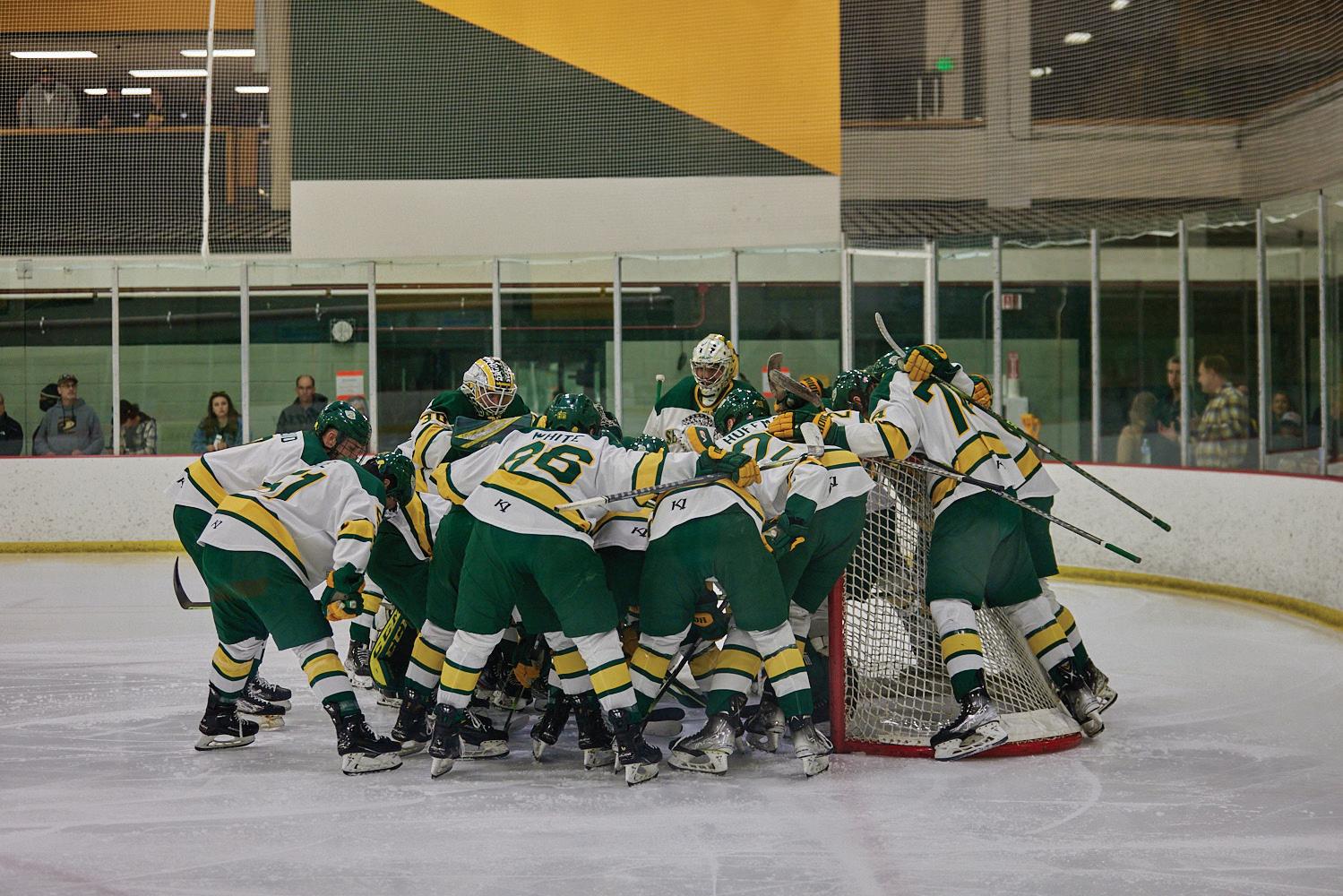
Though UAA hockey has successfully been reinstated, Seawolf 5th Line continues to support the team.
“[Seawolf 5th Line’s] mission is to support, advise and work collaboratively with the UAA administration, the com-
munity and the student body to establish plans and goals to solidify and grow the overall brand of UAA hockey locally, regionally and nationally,” Bethard wrote.
“Seawolf 5th Line [this year] helped negotiate the donation, so generously
provided by Avis Alaska, to replace the 43-year-old bleachers with new, more comfortable and safer bleachers.”
Seawolf 5th Line also paid for the jerseys that were auctioned off during the Green and Gold game on Sept. 23 and 24. Bethard said the profits help pay for team events.
“We will also do the same type of jersey auction for the ‘Pink Out’ game, and those proceeds go to the American Cancer Society.”
The UAA hockey team is grateful for Seawolf 5th Line and their support.
In an interview with TNL, hockey player Ben Almquist said “the 5th Line has done so much for the team and the program.”
“The constant support and events that they put on really make a difference. The experience at games and the whole feel of the team are where they are because of the support that the 5th Line provides.”
The non-profit that began three years ago to save Seawolf Hockey has emerged as a vital component of UAA hockey.
After reinstating UAA hockey and continuing to support the team on and off the ice, it’s fair to say that Seawolf 5th Line is accomplishing their mission.
UAA cross-country runs in Illinois, Nell Baker and Cole Nash fastest Seawolves The Seawolves took a trip to corn country to compete in the Lewis Crossover.
By Matthew Schmitz editor@thenorthernlight.org
It was sunny and slightly breezy on Saturday, Oct. 7, when the Seawolves lined up to race in Romeoville, Illinois. Runners took their place along the edge of a field that necked down to a grassy course that made up the route of the meet.
A livestream of the event was broadcast on the GLVC Sports Network.
Thirty one men’s teams and 33 women’s teams competed in the meet.
The women’s race was first, running a distance of 6K. UAA’s Nell Baker was the
fastest female Seawolf, coming in 28th.
Seawolves Tressa Wood and Avery Williamson came in 129th and 169th respectively, according to the race results.
The women’s team placed 22nd overall with 586 points.
Team scores are calculated by assigning the top five runners for each team points based on their standing. First place gets one point, second gets two, etc. The points are added up for each team and the team with the lowest score wins.
For the men’s race, the fastest Seawolf was Cole Nash. He placed 10th in the men’s 8K race.
Following him were Michael Zapher-
son in 16th and George Payne in 48th. The men’s team placed sixth overall with 230 points.
According to goseawolves.com, head coach Ryan Mcwilliams said that the team didn’t quite accomplish what they wanted to during the meet.
But he went on to say, “Even with everything not going our way, we competed well and hard in both races and are feeling confident going into this championship portion of the season.”
The last time the Seawolves competed in the Crossover was back in 2017, according to goseawolves.com. UAA’s Caroline Kurgat earned first place for the
women’s team, and the women’s team came in third place overall.
Nash made improvements on the placing of UAA’s Edwin Kangogo, who came in 19th in 2017. The men’s overall standing matched this year’s performance at 6th place. Though in 2017 the team earned 223 points, 7 less than this year. Looking forward, the Seawolves will be hosting the GNAC Championship for the first time in 22 years on Oct. 21 at Kincaid Park.
The event is free to the public and the women’s race is set to begin at 11 a.m. followed by the men’s race at noon. Visit goseawolves.com for the most up to date information.
Seawolves dominate Mariners in first hockey game of the season Matt Allen and Matt Kinash led the Seawolves by scoring multiple goals apiece.
By Avery Williamson sports2@thenorthernlight.org
The crowd was alive at the Avis Alaska Sports Complex as the Seawolves crushed the Vancouver Island Mariners in their first game of the season.
The most impressive part of UAA’s
performance on Sept. 29 doesn’t show up on a stat sheet though: team chemistry.
Because hockey was reinstated last season, the team was full of extremely talented – but also new – players. Since hockey is such a team-orientated sport, it’s difficult to play at a competitive level with such a young team.
However, the Seawolves are no longer a totally new team – and you can tell. Between their impressive scoring, winning 7-2 and supportive team play, the 2023-24 UAA hockey season is certainly going to be fun to watch based on this game.
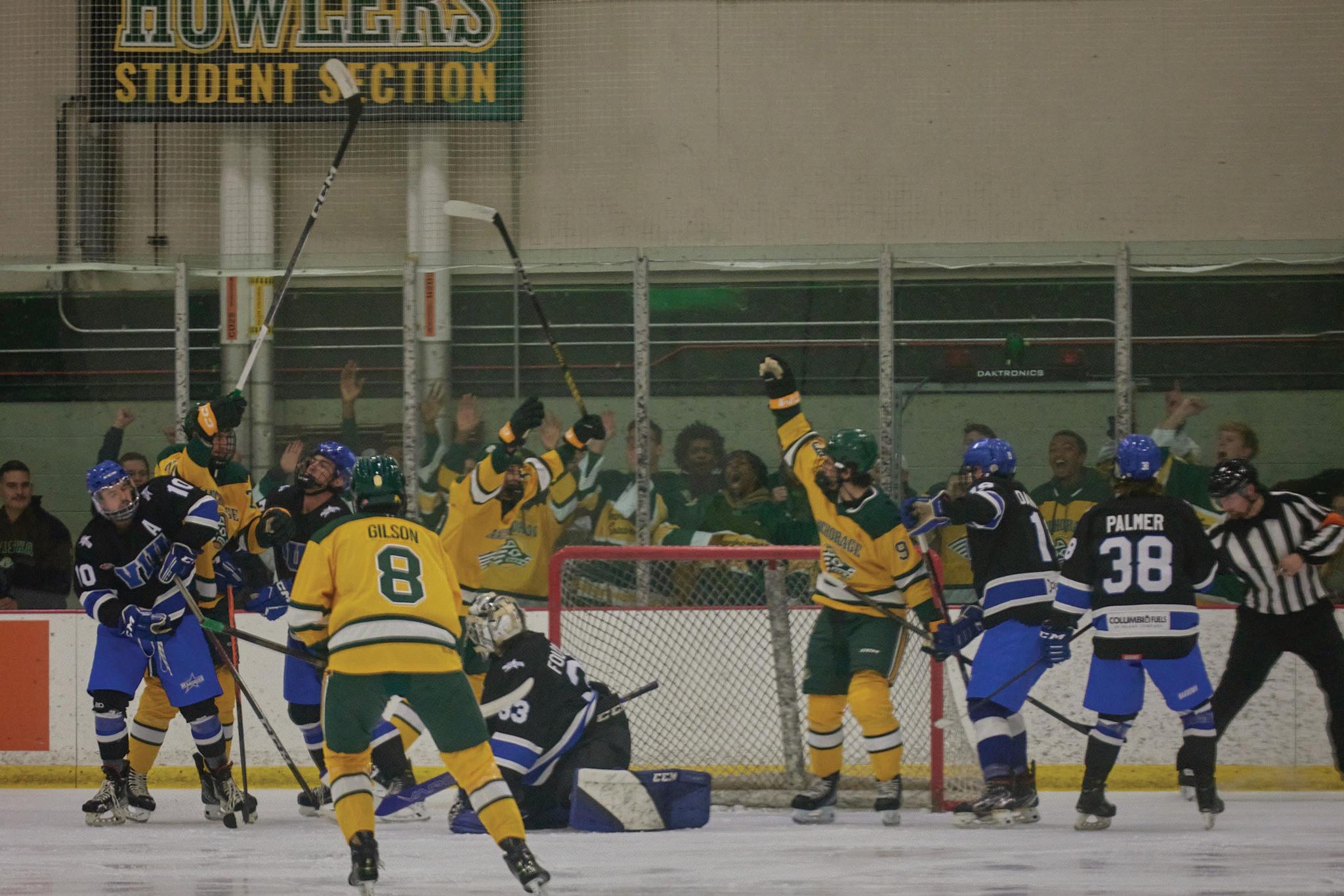
The Seawolves set the pace right from the first face-off. Just over four minutes into the game, Matt Kinash snuck the puck past the goalie to get the Seawolves on the scoreboard.
Only a few seconds later, Matt Allen scored, increasing the Seawolves’ lead to 2-0.
The Seawolves were on a roll, and Brett Bamber added his name to the scoresheet with a goal — again within seconds.
After each goal, the team celebrated by banging on the glass to get the crowd pumped and slapping each other on the back for congratulations.
The crowd responded with the same intensity as the players by screaming, clapping and ringing cowbells.
Though the Mariners responded with a goal of their own after Bamber’s, the Seawolves didn’t let this phase them. Instead, Kinash connected with the net for the second time, making the score 4-1.
With one minute left in the first period, the Mariners scored their second goal. But they weren’t able to find the net again for the rest of the night.
William Gilson added insult to Mariner injury with just over six minutes left in the second period, increasing UAA’s lead to 5-2.
Several fights were instigated by the Mariners following UAA’s fifth goal. The Seawolves didn’t seem to mind, though. Instead, they continued to shred the ice.
Only 75 seconds into the final period, Allen scored his second goal of the night. And Mitch Lafay concluded the scoring for the game with just under 14 minutes left until the final buzzer.
In a press release by GoSeawolves. com, head coach Matt Shasby said, “As a group it was a good opportunity for our freshmen to get some game reps and for some guys to try and build some chemistry.”
“We see we have some things to focus on this week in practice to be ready for next Saturday. We really appreciate Vancouver Island for making the trip.”
The Mariners were clearly frustrated by the Seawolves’ dominance, racking up 15 penalty minutes.
In the end, fighting our team didn’t help them score.
Head to GoSeawolves.com to check out the hockey team’s schedule this year. You don’t want to miss out on another game!
rise of the streamers created a new kind of problem for the media industry.
By Mark Zimmerman news4@thenorthernlight.org
The second week of January, 2007. The iPhone, of course, had just been announced at Macworld, but right next door in Los Gatos, something else entirely was brewing. That week, founder and CEO of Netflix Reed Hastings demonstrated the ability to play a movie or TV show from their vast library instantly over the web.
Prior to this, watching something “on” Netflix — which required renting physical discs — was a commitment.
Over-the-mail DVDs faced a combination of traditionallydelayed home video releases and disheartening shipping times. Competition from Apple
iTunes, cable video-on-demand and Amazon DVD also scared Netflix’s investors, worried now that the innovative startup was asleep at the wheel.
That was, until Hastings clicked that fateful play button, and Netflix entered a new age of media.
A believer in innovation over efficiency, Hastings was not averse to risk. Netflix was hewn from the same time and locale as Salesforce and Google, after all.
The Bay Area was a place for outsized investment and radical ‘web 2.0’ horizons, not a hideout for timid bookkeepers.
Thus, Netflix had to psychologically engineer studios and shareholders to survive. Frances Manfredi of NBC Universal – an early partner with Netflix – told the New York Times in
2007 that cable on-demand was still number one.
The $3 to $5 fees of cable video rentals seemed far more sustainable than magically unlimited streaming for an equally-magical $7 monthly fee. This was not optimization, however, but a Zuckerberg-esque growthhacking bid. Netflix assumed time and scale would heal all wounds, but underestimated how much scale it would need to break even.
Over the next decade, Netflix struggled to keep the illusion up. Their model severed entertainment from advertisements, cable fee payouts and even a la carte video revenue. Record amounts of show writing talent would pour into Hollywood to satiate new demand brought on by subsequent streaming services.
Studios hiked licensing fees to make streaming financially justifiable, thus forcing Netflix to invest millions into hastily-greenlit shows, movies and comedy deals, passing costs on to subscribers to make up for production. Studios — reluctantly responding to consumer expectations and Netflix’s monopoly – vertically integrated into new streaming ventures. By 2019, analysts were already declaring streaming saturation. Through the pandemic, traditional cost-related wisdom surrounding scale and competition became a punchline. Moments such as 1980’s infamous “Who shot JR” saga were sacrificed at the altar of targeted recommendation systems and paywalls – fragmenting shared cultural experiences. Netflix,
along with the rest of the industry, drowned in expenses. By the time 2023 rolled around, the vastly over-hired profession of screenwriting buckled under long waits for contracts and precipitous declines in recurring residuals. Viewer data obfuscation and the death of set broadcasts made residual calculation opaque. Netflix sat undisturbed by domestic production woes created by the Writer’s Guild strikes — later including the Screen Actors’ Guild-American Federation of TV and Radio Artists — but traditional media giants caved when Hollywood stopped to a halt for many months. Studios now ache from demands that streaming created — not to mention the eyeballs online content houses stole — and are lost in a desert of tech.
set
By Kaycee Davis features2@thenorthernlight.org
“A Weekend of Song,” produced by UAA’s Department of Music, featured two performances of the genre of art song, on Sept. 23 and Sept. 24 in the UAA Recital Hall in the Fine Arts Building.
The performances were a composition of 12 voice teachers from UAA and the Anchorage community. Each performance was divided into six singers who each sang a set of songs of their own choosing. I went on the first night.
In an interview with The Northern Light, Dr. Mari Hahn, a Department of Music professor and voice teacher who organized the event, said that “A Weekend of Song” brought community and university voice teachers together to sing – something that they do less of when they are training their students.
Hahn said that “art song is poetry set to music.” She said that it is a Western tradition that started in the late 18th century – the 1700s – designed for intimate spaces with a singer and a pianist, such as drawing rooms
and smaller spaces. Mozart was one of the genre’s early writers –he would have called an art song piece a “lieder” in German. The art song genre is better known in bigger cities in the United States, but Hahn explained that audiences outside of major metropolitan areas are not as familiar with it.
Many of the songs weren’t in English, so an electronic board behind the singers displayed translations.
It was easy to be taken in by the performances. Each performer was a standout, but a few moments were “firsts” for me.
Singer Eden Barrington entered the stage with pianist Janet Carr-Campbell. Carr-Campbell, the accompanist for the UAA Music Department wore black. Barrington’s long hair reflected the stage lights, and she was wearing a seafoam green dress over boots that looked like they were made of diamonds.
She was singing her second song, “Du bist die Ruh” by Franz Schubert when I felt drops of liquid fall on my hands. My immediate thought was that something was wrong with the sprinkler system. I looked up and realized that the liquid came
from me. My eyes were tearing up, and there were even more tears when I blinked. I had no idea what the words meant – I was just in the moment with the music and crying for reasons I did not know. I resolved to bring handkerchiefs with me to the next performance.
A critical moment happened for me when Michael Scarcelle was singing from a selection by Gerald Finzi. I realized that the pianist’s part of the song was not a mere accompaniment to the singer, but that there was a vocal-piano duet happening. Scarcelle sang in character and, when he paused and looked at Carr-Campbell, she played intricate, scrolling phrases that communicated intention with his singing.
Nancy Caudill’s final piece, “Rabbit at Top Speed” by Leonard Bernstein brought the house down with laughter. On the screen, there was a picture of a rabbit and she sang about how to cook a rabbit, according to Bernstein’s abbreviated recipe from a French cookbook. Her acting skills were top notch with dramatic facial expressions and hand gestures. The audience
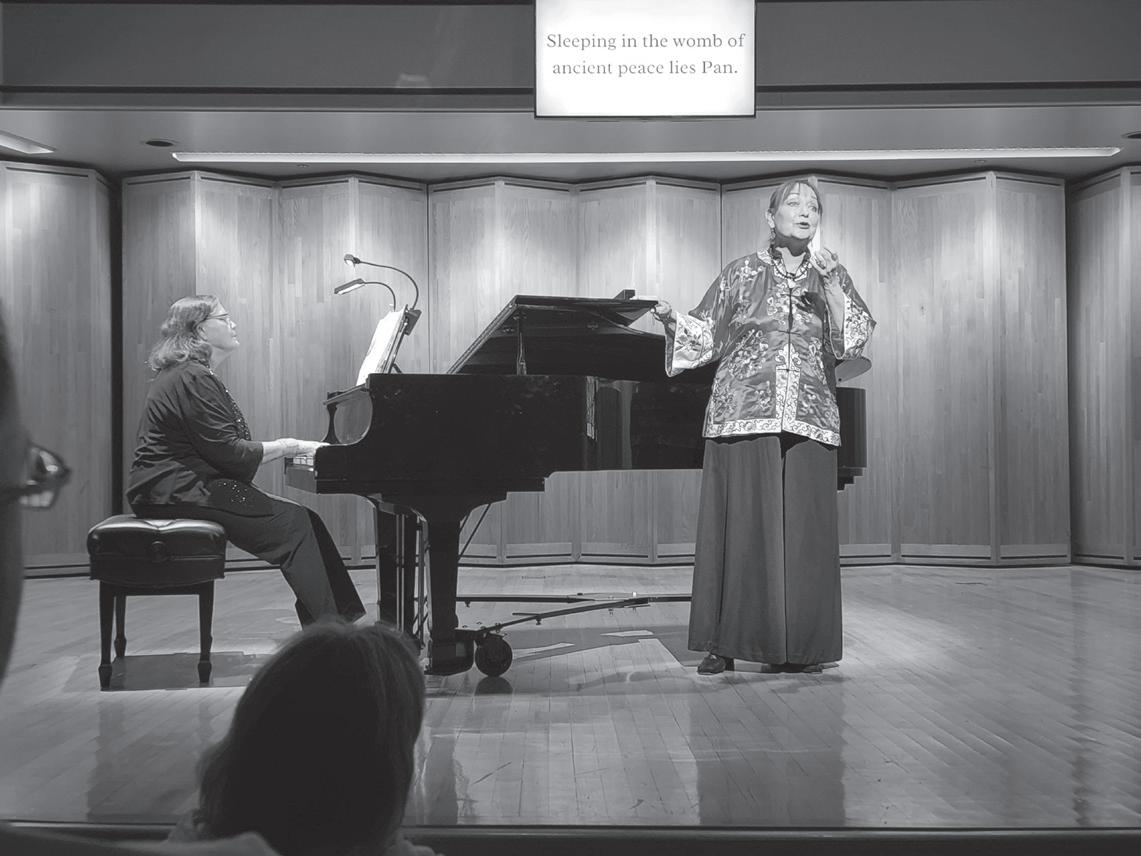
was enjoying themselves and got lost in the song.
I caught up with Caudill as I was walking to my car. I asked her how she came up with what to sing. She told me that she had just sung several of her songs at her son’s memorial service a few weeks before.
Her son, Gary Neumann, was a trained musician who played guitar and sang in a rock band. As an adult, he traveled to “very northern California,” and Caudill went to visit him, as they both loved the redwood forest. She said that her first song, “Crepusculo (Deita Silvane)” by Ottorino Respighi was dedicated to Gary. Crepusculo means
The Alaska Permanent Fund began in 1976 to give the people a portion of the state’s oil revenues. It’s time to rethink its viability.
By Avery Williamson sports2@thenorthernlight.org
Every year Alaskan residents look forward to October because the Permanent Fund Dividend means more money in their bank accounts. Though everyone is eager for extra money, the Alaska Permanent Fund may have more disadvantages than we think.
The state has seen declining oil production and revenue for decades, yet Alaskans have grown dependent on the yearly disbursement, which won’t last forever.
Many Alaskans count down the days until the PFD disbursement because this money helps
them make it through the year.
According to a study by the Economic Security Project, “79% of Alaskans say the PFD is an important source of income for people in their community, with 85% saying it helps the Alaskan economy and 81% saying it improves their quality of life.”
This statistic raises a question: Is there a problem if 79% of Alaskans rely on the PFD for income?
In an interview with Paul Dunscomb, a professor in the Department of History at UAA, he describes Alaskans’ dependency on the PFD.
“It’s certainly the case that for many rural Alaskans the PFD is a vitally important seg-
ment of their yearly income,” said Dunscomb.
“Whether this represents a good thing or a bad is perhaps more debatable.”
In addition to dependency, research shows that poor spending habits and substance abuse increase in correlation to the distribution of the PFD.
In an article from the UAA Institute of Social and Economic Research, Associate Professor of Economics Mouhcine Guettabi wrote:
“Alaskans spend significantly more non-durables (such as cosmetics, cleaning products, food, fuel, and other consumables) and services in the month when they receive the dividend payment, and this excess consump -
tion persists over the first quarter after the dividend payment.”
Some people also spend their PFD on drugs.
“In the four weeks after the distribution of the PFD, what we’re calling substance use-related incidents increase by about 10%,” Alaska Public Media reported.
Lastly, the viability of the PFD must be considered. The fund emerged to give residents a portion of oil revenues, but Alaska’s oil production has decreased significantly since 1976.
According to the Alaska State Profile and Energy Estimates, Alaska’s “annual oil production was the lowest in more than 45 years” in 2021 and 2022.
This statistic brings to question the long term viability of the PFD.
“The problem is that since
“twilight,” and she and Gary loved to watch the sun come up in the redwoods.
Each of Caudill’s pieces had significance to her son, and when asked about “Rabbit at Top Speed,” she laughed. “Gary and I liked to cook together, but we were both vegetarians!”
The recital was outstanding, and every performance by each singer held the audience. To my fellow Seawolves, I encourage you to attend any of the Music Department’s offerings to expand your knowledge of in-person performances, support the arts and have a wonderful evening out.
the collapse of the price of oil in 2014, Alaska’s career as a petrostate came to an end, and while oil and gas will always be an important part of Alaska’s economy, it will never be able to support us in the style to which we have become accustomed,” said Dunscomb.
Here’s the reality: Alaska is no longer an oil-state. This means we simply don’t have enough money to give away to every resident each year.
The PFD’s evolution into an important source of income for many Alaskans can have dire consequences. If PFD payments become a thing of the past, people will struggle to support themselves and their families. Currently, the state has no plans for averting this probable scenario.
Our state has changed drastically since 1976, it’s time the PFD does too.
By Hannah Dillon opinion2@thenorthernlight.org
The Student Union has new additions to its maintenance program, two multi-use recycling bins. There are slots for aluminum/plastics, paper material and landfill.
The recycling bins have been added to the top floor of the Student Union, with one next to the Student Services Center and the other between the lending library and the Avis Alaska Sports Complex entrance.
The recycling bins were purchased from manufacturer MaxR, where organizations can buy customized recycling bins.
Student Union Assistant Director Cody Buechner played a role in acquiring the new bins.
Buechner explained that there is another recycling bin from the same brand in the Gorsuch Commons. It was acquired sometime in the past, but the bin does not have Seawolf branding.
Buechner thought that similar bins could be used in other places on campus.
“I had brought this up to a few folks around campus and it was determined that the Student Union should run the pilot pro -
3211 Providence Drive Student Union 113 Anchorage, AK 99508
Executive Editor
Matthew Schmitz (907) 786-1313 editor@thenorthernlight.org
News Editor Taylor Heckart news3@thenorthernlight.org
Sports Editor Avery Williamson sports2@thenorthernlight.org
Multimedia Editor Jay Witworth multimedia1@thenorthernlight.org
Layout Editor
Linnaea Gossard layout@thenorthernlight.org
Copy Editor Kyle Ivacic news2@thenorthernlight.org
Reporter Kaycee Davis features2@thenorthernlight.org
Reporter Hannah Dillon opinion2@thenorthernlight.org
Audio Reporter Mark Zimmerman news4@thenorthernlight.org
Graphic Designer Tressa Wood graphics@thenorthernlight.org
gram on it,” said Buechner.
Once the program was accepted, Buechner ordered two bins, which arrived mid-September. These new recycling bins are branded with UAA’s Seawolf logo.
Buechner notes that the UAA spirit should be represented throughout each building on campus.
“It leads to more pride in the school here. As soon as you’re in this building and Enrollment Services area, you should know you’re in Seawolf Nation. It shouldn’t be [just] another building. The bins are just one more piece to it,” said Buechner.
Buechner explained that the decision to buy only two bins was due to shipping costs and the price of the bins. The total price tag for both bins was $9,000.
The large expense for the bins may seem shocking, but Buechner explained that the standard blue recycling bins have been in nearly every campus building for a very long time. Something new and refreshing can visually improve many areas on campus.
“They’re not cheap but they are made to last, they’re warrantied and they can be used indoors and outdoors. To me, it’s
another sustainable effort that increases school affinity,” said Buechner.
The bins are paid for through staff savings, which is left over money from when a UAA staff member leaves their position and the opening for the position remains vacant for some time.
Though the bins originate from the UAA budget, staff savings can help minimize the financial burden.
“We supply the funds through our budget with staff savings after we had some folks who weren’t in the position all year. At least we’re maximizing those dollars,” said Buechner.
Bin orientation is also important as Buechner explained that many people simply throw trash and food items into the recycling slot.
“Here in Alaska, you can recycle only plastics 1 and 2, we can’t do the shrinkwrap, we can’t do the packaging and we do commingle paper and cardboard. I feel folks just want to do the right thing but they’re really not helping the cause. I hope that, through the extra language on these bins and how easy it is to navigate what goes in which, that it helps us recycle better,” said Buechner.

Web Manager Selena Im webmanager@thenorthernlight.org
Photographer Justin Cox photographer@thenorthernlight.org

The Northern Light is a proud member of the Associated Collegiate Press. The Northern Light is a bi-weekly UAA publication funded by student fees and advertising sales. The editors and writers of The Northern Light are solely responsible for its contents. Circulation is 1,500. The University of Alaska Anchorage provides equal education and employment opportunities for all, regardless of race, color, religion, national origin, age, sex, Vietnam-era or disabled-veteran status, physical or mental disability, changes in marital status, pregnancy or parenthood. The views expressed in the opinion section do not necessarily reflect the views of UAA or the Northern Light.
The University of Alaska is an affirmative action/equal opportunity employer and educational institution. The University of Alaska does not discriminate on the basis of race, religion, color, national origin, citizenship, age, sex, physical or mental disability, status as a protected veteran, marital status, changes in marital status, pregnancy, childbirth or related medical conditions, parenthood, sexual orientation, gender identity, political affiliation or belief, genetic information, or other legally protected status. The University’s commitment to nondiscrimination, including against sex discrimination, applies to students, employees, and applicants for admission and employment. Contact information, applicable laws, and complaint procedures are included on UA’s statement of nondiscrimination available at www.alaska. edu/nondiscrimination.
The Northern Light encourages readers to express their views in the newspaper. The Northern Light reserves the right to reject or publish any submission, online or in print.
Letters to the editor can be submitted to editor@thenorthernlight.org. The maximum length for a letter to the editor is 300 words, and 150 words for letters specifically endorsing candidates for federal, local, or university office. A letter to the editor is written by someone who does not have authoritative knowledge on the subject they are discussing. Contributors are restricted to one published letter to the editor per month.
Media Adviser Paola Banchero
Administrative Adviser Zac Clark
Fiscal Technician Micah Perino
The Northern Light is hiring! See our job listings at careers.alaska.edu.
Opinion pieces can be submitted to editor@thenorthernlight.org. The maximum length for a contributor’s opinion piece is 500 words. Contributors are restricted to one published opinion piece per month. Opinion pieces written by staff of The Northern Light are limited to 1,000 words. An opinion piece that is published in The Northern Light should be written by someone who has authoritative knowledge on the subject they are discussing.
Letters and opinion pieces are subject to editing for grammar, accuracy, length and clarity. All letters and opinion pieces must include names, major and/or group affiliation and contact information for verification purposes. The Northern Light will not publish anonymous letters or pseudonyms. Requests for corrections can be sent to editor@thenorthernlight.org. Print publication is subject to accuracy and available space. All corrections are posted online with the original story at www. thenorthernlight.org. The deadline for submissions is the Friday before publication at noon, no exceptions.
The Northern Light newsroom is located on the first floor of the Student Union Room 113.
UAA event list for Wednesday, Oct. 11 to Sunday, Oct. 15.
By Selena Im webmanager@thenorthernlight.org
Events happening throughout the week:
Alaska Theatre of Youth Presents Ghostlight
You won’t want to miss this incredible play by Stephen Gregg and directed by Rachael Haart. With special lighting effects, live sound effects and plot twists, this family friendly play is sure to astound and entertain!
Fine Arts Building Harper Studio
Thursday Oct. 12 from 10 to 11:30 a.m.
Friday Oct. 13 from 7:30 to 9
p.m.
Saturday Oct. 14 from 1:30 to 3 p.m. and 7:30 to 9 p.m.
Monday Oct. 15 from 3 to 4:30 p.m.
Canoe Battleship with Residence Life
Join UAA Residence Life as they host Canoe Battleship, where UAA students try to sink each other’s canoes until only one team remains a float.
Avis Alaska Sports Complex
Thursday, Oct. 12 from 6 to 8 p.m.
Friday, Oct. 13 from 6 to 8 p.m.
Perseverance Theatre Presents, Hedwig and the Angry Inch
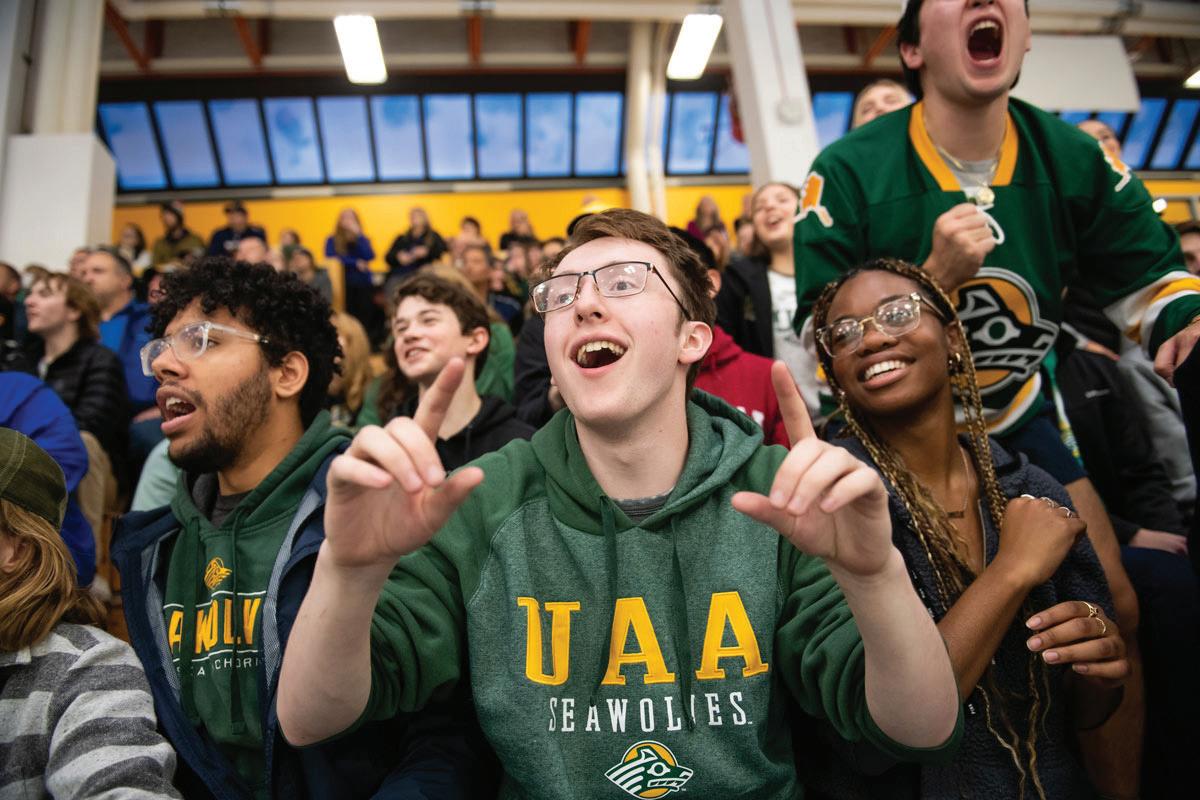
Hedwig, a survivor of botched surgery and human trafficking, pursues rockstar fame despite venue limitations.
Fine Arts Building Mainstage
Theater
Friday Oct. 13 from 7:30 to 9:30 p.m.
Thursday Oct. 14 from 7:30 to 9:30 p.m.
Saturday Oct. 15 from 4 p.m. to 6 p.m.
Wednesday Oct. 11
Good Day, Seawolves! With Fraternity and Sorority Life
Join UAA Fraternity & Sorority Life for a midday break with free snacks and resources. Rasmuson Hall
From 11 a.m. to 1 p.m.
Noon Music with DJ Desert Rose Enjoy live music from DJ Desert
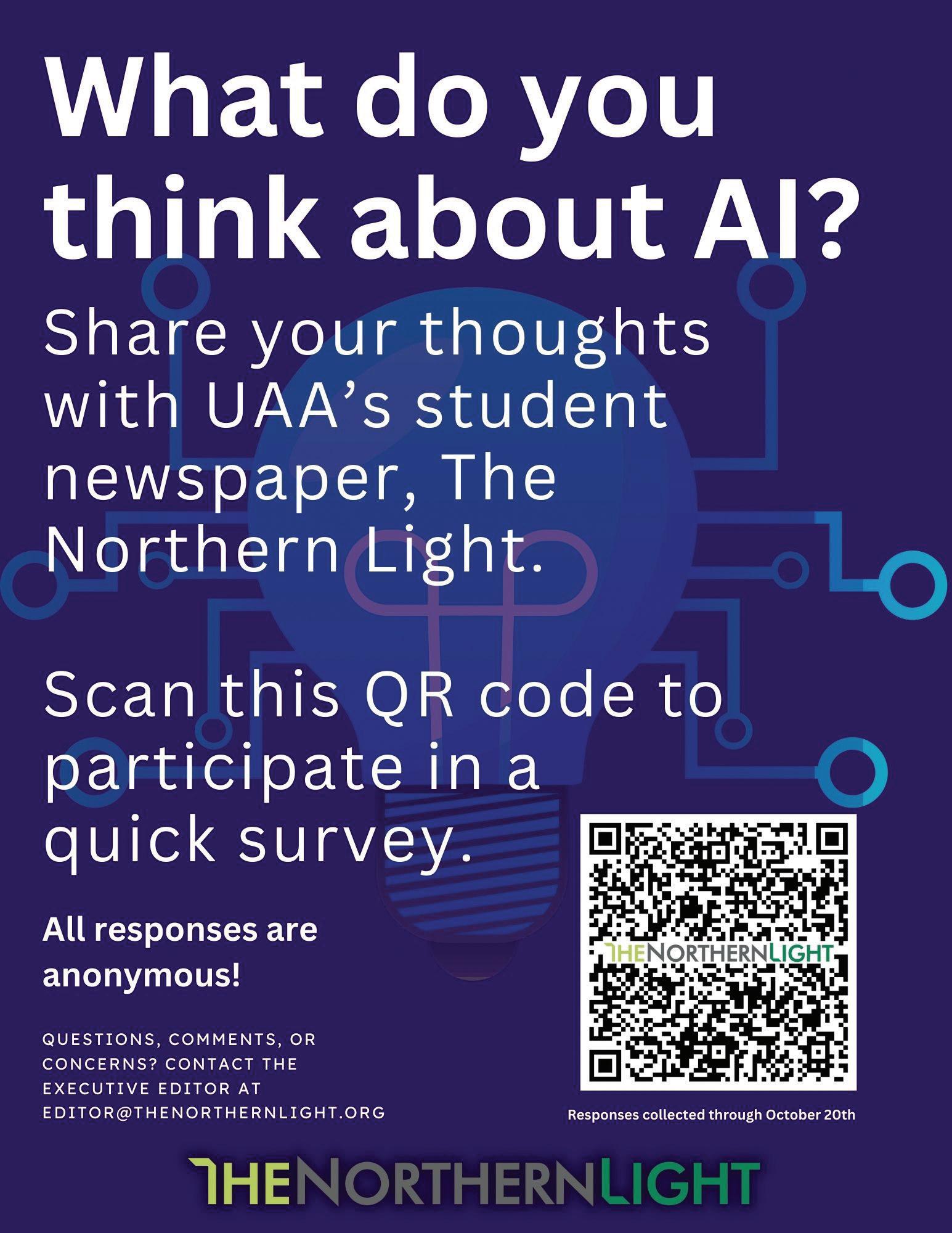
rior State Avis Alaska Sports Complex Starts at 3:07 p.m.
UAA Alumni Homecoming luncheon
Join UAA’s Homecoming Luncheon with keynote Cal Williams and guest speaker BradHillwig on the theme “Partners in Education.
Alaska Airlines Center
From 11 a.m. to 1 p.m.
UAA Department of Music Student Recital
Ed Clinton’s passion for the arts lives on through his wife Barbara’s generous endowment to the UAA Department of Music, supporting concerts, renowned artists, and music scholarships, enriching the program.
Fine Arts Building Recital Hall From 3 to 4 p.m.
Ghost Tours and Superstitions
Discover Wendy Williamson’s haunts with tours, trivia, and more.
Wendy Williamson Auditorium
From 4 to 7:30 p.m.
The College and Business of Public Policy Showcase
Rose during the lunch hour. Presented by UAA Concert Board. Student Union Cafeteria From 12 to 1 p.m.
International Student Organization Meeting Fall 2023 Rasmuson Hall Room 110 From 4 to 5 p.m.
Arcade Alumnight Enjoy an open esports gaming night for current students and UAA Alumni.
Student Union Esports Lounge From 4 to 7 p.m.
Thursday Oct. 12
Seawolves Volleyball vs Central Washington
UAA Alaska Airlines Center Starts at 7 p.m.
Good Day, Seawolves. With enrollment services (Free Food)
Join UAA Career Services for a mid-day break with free coffee, snacks and activities.
Enrollment Services
From 11:30 a.m. to 1 p.m.
Friday, Oct. 13
Seawolves Volleyball vs Central washington Alaska Airlines Center Starts at 7 p.m.
Seawolf Hockey vs Lake Supe -
Join UAA’s Homecoming Luncheon with keynote Cal Williams and guest speaker Brad Hilwig on the theme”Partners in Education.”
Rasmuson Hall
From 5 to 7:30 p.m.
Homecoming Headphone Disco
Kick off your weekend with a headphone disco dance party, hosted by the UAA Concert Board.
Student Union From 8 to 11 p.m.
Saturday, Oct. 14
Volleyball Pre-game party
Alaska Airlines Center Starts at 5 p.m.
Seawolves Volleyball vs Northwest Nazarene
Alaska Airlines Center Starts at 7 p.m.
Seawolf Hockey vs Lake Superior State
Avis Alaska Sports Complex Starts at 2:07 p.m.
National Association of Teachers of Singing Voice Competition (Music Theater)
Fine Arts Building Recital Hall. From 9 to 7 p.m.
Sunday, Oct. 15
UAA Faculty Chamber Recital Fine Arts Building Recital Hall From 4 to 6 p.m.
